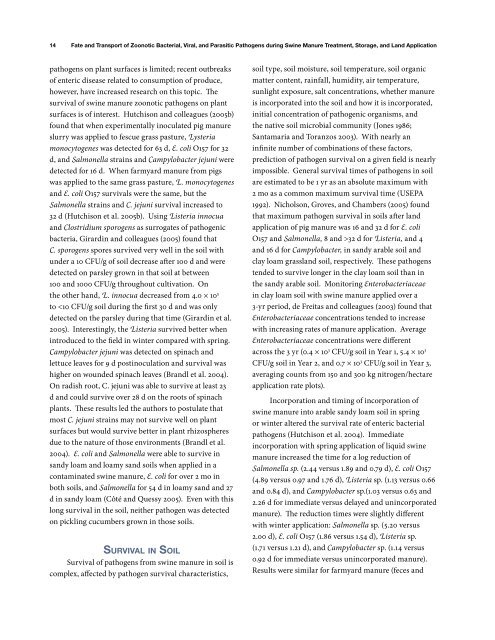Fate and Transport of Zoonotic Bacterial, Viral, and - The Pork Store ...
Fate and Transport of Zoonotic Bacterial, Viral, and - The Pork Store ...
Fate and Transport of Zoonotic Bacterial, Viral, and - The Pork Store ...
Create successful ePaper yourself
Turn your PDF publications into a flip-book with our unique Google optimized e-Paper software.
14<br />
<strong>Fate</strong> <strong>and</strong> <strong>Transport</strong> <strong>of</strong> <strong>Zoonotic</strong> <strong>Bacterial</strong>, <strong>Viral</strong>, <strong>and</strong> Parasitic Pathogens during Swine Manure Treatment, Storage, <strong>and</strong> L<strong>and</strong> Application<br />
pathogens on plant surfaces is limited; recent outbreaks<br />
<strong>of</strong> enteric disease related to consumption <strong>of</strong> produce,<br />
however, have increased research on this topic. <strong>The</strong><br />
survival <strong>of</strong> swine manure zoonotic pathogens on plant<br />
surfaces is <strong>of</strong> interest. Hutchison <strong>and</strong> colleagues (2005b)<br />
found that when experimentally inoculated pig manure<br />
slurry was applied to fescue grass pasture, Lysteria<br />
monocytogenes was detected for 63 d, E. coli O157 for 32<br />
d, <strong>and</strong> Salmonella strains <strong>and</strong> Campylobacter jejuni were<br />
detected for 16 d. When farmyard manure from pigs<br />
was applied to the same grass pasture, L. monocytogenes<br />
<strong>and</strong> E. coli O157 survivals were the same, but the<br />
Salmonella strains <strong>and</strong> C. jejuni survival increased to<br />
32 d (Hutchison et al. 2005b). Using Listeria innocua<br />
<strong>and</strong> Clostridium sporogens as surrogates <strong>of</strong> pathogenic<br />
bacteria, Girardin <strong>and</strong> colleagues (2005) found that<br />
C. sporogens spores survived very well in the soil with<br />
under a 10 CFU/g <strong>of</strong> soil decrease after 100 d <strong>and</strong> were<br />
detected on parsley grown in that soil at between<br />
100 <strong>and</strong> 1000 CFU/g throughout cultivation. On<br />
the other h<strong>and</strong>, L. innocua decreased from 4.0 × 10 5<br />
to 32 d for Listeria, <strong>and</strong> 4<br />
<strong>and</strong> 16 d for Campylobacter, in s<strong>and</strong>y arable soil <strong>and</strong><br />
clay loam grassl<strong>and</strong> soil, respectively. <strong>The</strong>se pathogens<br />
tended to survive longer in the clay loam soil than in<br />
the s<strong>and</strong>y arable soil. Monitoring Enterobacteriaceae<br />
in clay loam soil with swine manure applied over a<br />
3-yr period, de Freitas <strong>and</strong> colleagues (2003) found that<br />
Enterobacteriaceae concentrations tended to increase<br />
with increasing rates <strong>of</strong> manure application. Average<br />
Enterobacteriaceae concentrations were different<br />
across the 3 yr (0.4 × 10 3 CFU/g soil in Year 1, 5.4 × 10 3<br />
CFU/g soil in Year 2, <strong>and</strong> 0.7 × 10 3 CFU/g soil in Year 3,<br />
averaging counts from 150 <strong>and</strong> 300 kg nitrogen/hectare<br />
application rate plots).<br />
Incorporation <strong>and</strong> timing <strong>of</strong> incorporation <strong>of</strong><br />
swine manure into arable s<strong>and</strong>y loam soil in spring<br />
or winter altered the survival rate <strong>of</strong> enteric bacterial<br />
pathogens (Hutchison et al. 2004). Immediate<br />
incorporation with spring application <strong>of</strong> liquid swine<br />
manure increased the time for a log reduction <strong>of</strong><br />
Salmonella sp. (2.44 versus 1.89 <strong>and</strong> 0.79 d), E. coli O157<br />
(4.89 versus 0.97 <strong>and</strong> 1.76 d), Listeria sp. (1.13 versus 0.66<br />
<strong>and</strong> 0.84 d), <strong>and</strong> Campylobacter sp.(1.03 versus 0.63 <strong>and</strong><br />
2.26 d for immediate versus delayed <strong>and</strong> unincorporated<br />
manure). <strong>The</strong> reduction times were slightly different<br />
with winter application: Salmonella sp. (5.20 versus<br />
2.00 d), E. coli O157 (1.86 versus 1.54 d), Listeria sp.<br />
(1.71 versus 1.21 d), <strong>and</strong> Campylobacter sp. (1.14 versus<br />
0.92 d for immediate versus unincorporated manure).<br />
Results were similar for farmyard manure (feces <strong>and</strong>


